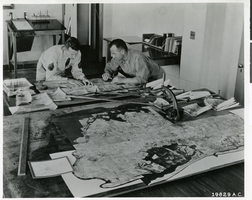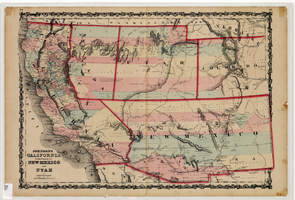Search the Special Collections and Archives Portal
Search Results
Lockheed 14 at Floyd Bennett Field, New York, 1938 July 10
Level of Description
Archival Collection
Collection Name: Howard Hughes Public Relations Photograph Collection
Box/Folder: Folder 05
Archival Component
Hiram "Tommy" Thurlow on the Lockheed 14, New York, 1938 July 09
Level of Description
Archival Collection
Collection Name: Howard Hughes Public Relations Photograph Collection
Box/Folder: Folder 05
Archival Component
Hiram "Tommy" Thurlow on the Lockheed 14, New York, 1938 July 09
Level of Description
Archival Collection
Collection Name: Howard Hughes Public Relations Photograph Collection
Box/Folder: Folder 05
Archival Component
Hiram "Tommy" Thurlow on the Lockheed 14, New York, 1938 July 09
Level of Description
Archival Collection
Collection Name: Howard Hughes Public Relations Photograph Collection
Box/Folder: Folder 05
Archival Component

Photograph of Army Air Forces officers, Mitchell Field, New York, circa 1940s - 1950s
Date
Archival Collection
Description
Image
T-Shirt Color: Navy Blue; Front: In Memory Of FDNY New York's Finest 9-11; Back: Impressionistic Art Piece Of New York City With Two Towers Burning And American Flag For The Sky; Handwritten Text: F-22 Donna Rimmer Knoxville, Tn., approximately 2001-2012
Level of Description
Archival Collection
Collection Name: New York-New York Hotel and Casino 9-11 Heroes Tribute Collection
Box/Folder: Box 30
Archival Component

Map of California and territories of New Mexico and Utah, circa 1861
Date
Description
Prime meridians: Greenwich and Washington
Plates 54 & 55 removed from Johnson's New illustrated family atlas of the world, with descriptions geographical, statistical and historical ... New York, 1862
Title page of atlas.
Image
T-Shirt Color: Navy Blue; Front: New York City; Back: Never Forget FDNY 343 WTC 9-11-2001, approximately 2001-2012
Level of Description
Archival Collection
Collection Name: New York-New York Hotel and Casino 9-11 Heroes Tribute Collection
Box/Folder: Box 85
Archival Component
New York University Graduate School of Business Administration, "A Study of the Economic Impact of the Change in the Pari-mutuel Tax on the Pari-mutuel Industry of New York State", 1980
Level of Description
Archival Collection
Collection Name: Eugene Martin Christiansen Papers
Box/Folder: Box 085
Archival Component
Hughes H-1 Racer photographs, 1935-1945
Level of Description
Scope and Contents
Materials contain photographs of the Hughes H-1 Racer aircraft from 1935 to 1945. The photographs primarily depict Howard Hughes standing with the plane or in the plane's cockpit. The plane was designed by Glenn Odekirk and built by Hughes Aircraft Company in 1935, the first plane produced by the company. Hughes broke several records in the H-1, including the landplane speed record in 1935. In 1937, Hughes broke his own transcontinental speed record by flying from Los Angeles, California to New York City, New York in 7 hours, 28 minutes. Despite its speed, Hughes was unable to sell the H-1 to the U.S. military.
Archival Collection
Collection Name: Howard Hughes Professional and Aeronautical Photographs
Box/Folder: N/A
Archival Component
